Fire power for all occasions. Overview of combat modules and towers for cars of light and medium weight categories (1 part from 5)

Hitrole Light combat module from Oto Melara on Lince machine in Afghanistan. The Italian army has ordered a Hitrole Light combat module for 81.
The need for enhanced protection and all-round observation played a major role in the development of a lightweight remote-controlled combat module (SDM) (RCWS acronym - remotely controlled weapon station) for light vehicles designed for patrol, reconnaissance and combat missions. Thus, these modules represent a winning alternative to weapons on a rotary axis, which the arrow is prone to “substitute” under enemy fire. They are also an alternative to single towers - too heavy for most light cars.
In addition to the above, the threat to supply routes in asymmetric scenarios has led to a new potential market for such systems, that is, their installation on procurement machines. In addition, outdated wheeled or tracked armored personnel carriers, initially equipped with installations on a rotary axle, found a solution in maintaining the combat capability of the anti-aircraft defense system, provided, of course, that the protection and mobility were sufficient.
The need to protect numerous advanced operational bases and combat posts (which is characteristic of the Afghan mission), however, led to the use of the DBMS also to protect these objects. Here, the stabilization of the module becomes redundant and, thus, some companies seek to offer cheaper solutions in an era of shrinking budget shagreen. As already noted, SDMs provide not only fire power, but also thanks to their optical-electronic sighting systems they play a useful role in situational awareness, observation, and when connected to a recording device, they collect intelligence data. Thermal imagers, included with the composition of optical-electronic units, definitely have their own and considerable cost (especially uncooled), but at present prices for them are decreasing.
Another cost issue is the ability to decouple weapons and sights. Today, it is considered more tactful to observe from a car without turning weapons on civilians, that is, the ability to maintain a machine gun at the maximum angle of elevation while simultaneously rotating the observation device can definitely be a diplomatic advantage. Another problem that causes numerous disputes is the loading of ammunition under armor protection, since it leads to heavier construction and corresponding high cost, but guarantees maximum security in combat.
Medium-caliber systems armed with 20-50 mm automatic guns are installed in habitable or uninhabited towers or in remote combat modules. The advantage of the towers is that they protect weapons and ammunition from the weather and from enemy fire. Habitable towers require ballistic protection, the same as for the carrying body, which makes them relatively heavy. Also, as the caliber increases, the fierceness of the debate over whether to leave the commander and the shooter next to the cannon or plant them inside the corps grows.
The main advantage of the remotely controlled tower is the absence of a basket, which increases the volume of the fighting compartment and reduces the need for high levels of ballistic protection (Level 2 is more than sufficient) and, thereby, helps to reduce weight. The controversial issue, taken from the experience gained in the lower echelons, is that the presence of a hatch allows the commander to have a direct overview of the terrain. And while the lighter DBMS can be installed so that one of the hatches on the machine opens freely, medium-caliber towers do not allow such a solution. Thus, as in the case with inhabited towers, a sunroof on the tower itself is needed. This determines the presence of a hole in the roof of the car for access to the tower (a decision often made for maintenance and reloading of ammunition from under the armor), as well as the presence of an open passage for the commander to access the hatch on the roof of the tower. However, the lack of a basket can lead to a restriction of the system’s movements, since for safety reasons the tower usually stops when the personnel moves up and down. Aiming systems increase the range of weapons and provide better opportunities for surveillance; in addition, medium-caliber towers are often equipped with panoramic sights for the commander - a privilege available until recently only by the main combat tanks.
The experience gained clearly confirmed the importance of observing and detecting targets. Therefore, many armies set sighting systems for such tasks rather than for obtaining search and strike capabilities. Another often considered solution can be called a “tower on a tower”, when a light OWM is installed on a medium or large caliber tower to provide not only observation (albeit with worse performance than long-range devices, such as panoramic sights), but also to protect close distances.
Progress in materials and improved recoil systems made it possible to manufacture towers armed with 105-mm and 120-mm high-pressure tank guns for chassis with a mass of 25 tons and above. While wheeled platforms on which such towers could be installed are available in relatively limited quantities, most tracked platforms can withstand the mass and forces of the recoil of the main battle tank, which thus turns them into full-fledged light tanks. As noted in a recent review of the BMP and BTR (December 2013), the trends regarding the mass of platforms are quite contrasting: who until recently was an adherent of “heavyweights”, for example, Israel, are currently looking at solutions in the medium-weight category, while as those who advocated mobility and operational deployment, such as the United States, seem to be moving in the opposite direction - towards heavier platforms. Nevertheless, it remains true that MBT is not the most vital decision for those armies that do not rely on military operations throughout the spectrum, and the abundance of towers of different masses, calibers and configurations can satisfy many of today's needs.
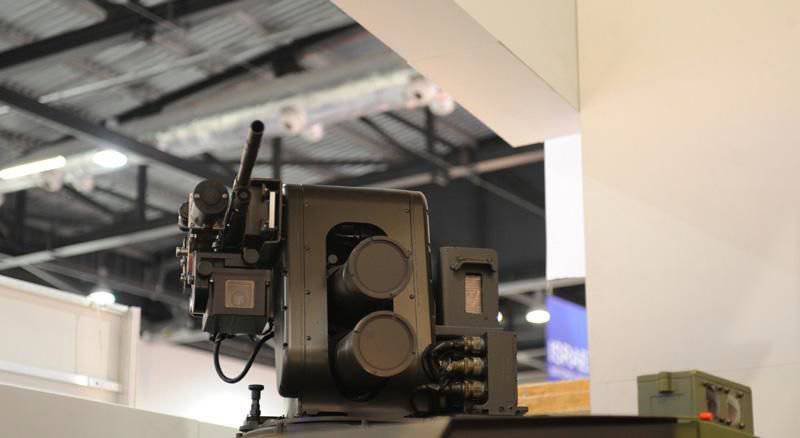
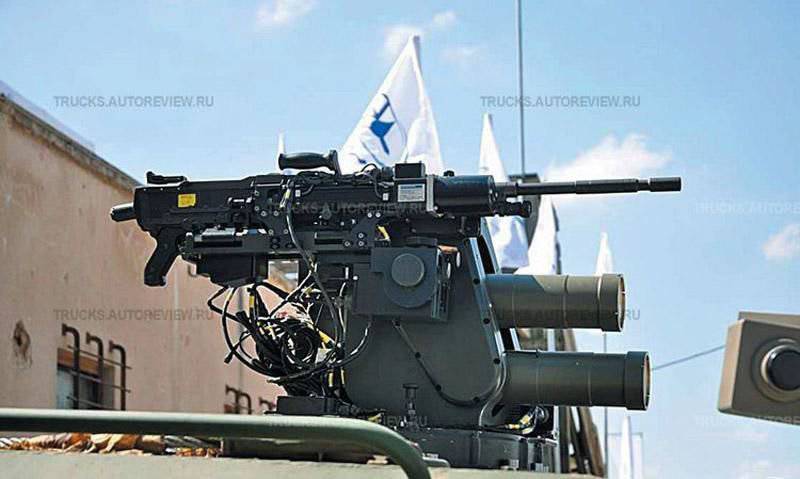
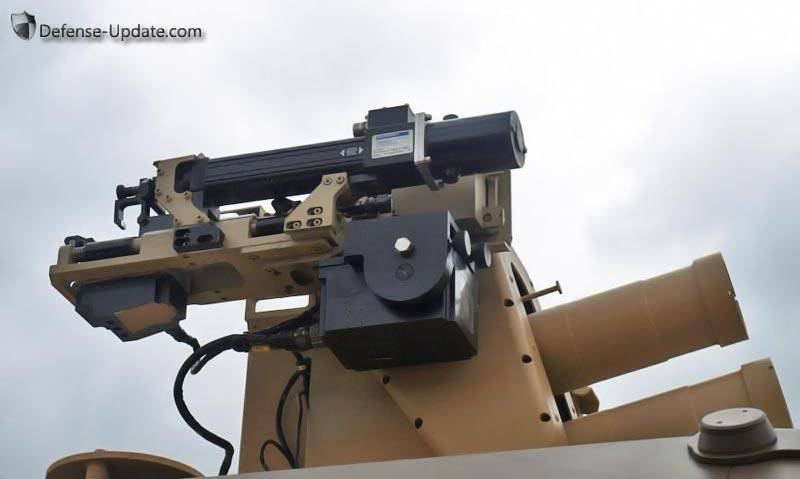
In its Bright Arrow module, Israel Military Industries has combined active protection with automatic weaponsgetting an effective defensive remedy for light armored vehicles
Light combat modules
While most of the SDMs can have 5,56-mm, 7,62-mm and 12,7-mm machine guns and 40-mm automatic grenade launchers, some of them can also accept small-caliber automatic cannon, which can also be installed in mid-caliber towers and into combat modules, becoming the link between these two categories.
KONGSBERG PROTECH
The Norwegian company, part of the Kongsberg Group, remains the largest supplier of SDMs, almost 17000 of such systems are supplied to 17 countries. Its Protector module was developed in various versions, becoming a kind of benchmark in the field of light SDMs; This system is constantly being upgraded to meet new market needs. Based on the operating experience of the M151 module, which has smoke grenade installations, the Norwegian company developed the M153 model, in which smoke grenade installations were removed in favor of ballistic side protection and a new loading mechanism. This model won the contract of the American Army Crows II in 2007, followed by several more contracts, the last of which was in September of 2013. According to real-life data, the adoption of the Crows II model made it possible to reduce the consumption of 12,7-mm cartridges by 70% due to a sharp increase in the accuracy of hitting from the first shot. Another major contract was received from an unnamed buyer in November 2012 of the year, and in April 2013 of the year another contract was signed for an unbreakable number of Protector modules in the Nordic configuration as part of a framework agreement drawn up by Norway and Sweden two years earlier. Nordic is currently the most advanced version of the Protector family; in addition to its 4 generation fire control system, it is distinguished by a new, self-developed sensor set that includes three separate cameras with different fields of view from 1,6 ° to 95 °. The latter value is provided by the Kongsberg Day Camera VIS 95 day camera, which significantly improves situational awareness, while the infrared laser with a wavelength of 850 nm provides high accuracy. In addition, Nordic also allows you to separate the movement of weapons and sensor unit in the vertical plane in order to have a “non-threatening appearance” when conducting surveillance in non-combat operations. A version with three cameras is also being developed, which will allow the screen to get a “picture-in-picture” mode based on three images with different fields of view. In May, 2013 of the year, Croatia signed a contract for an SDS Protector to install it on AMV 8x8 machines manufactured under license from the Finnish company Patria.
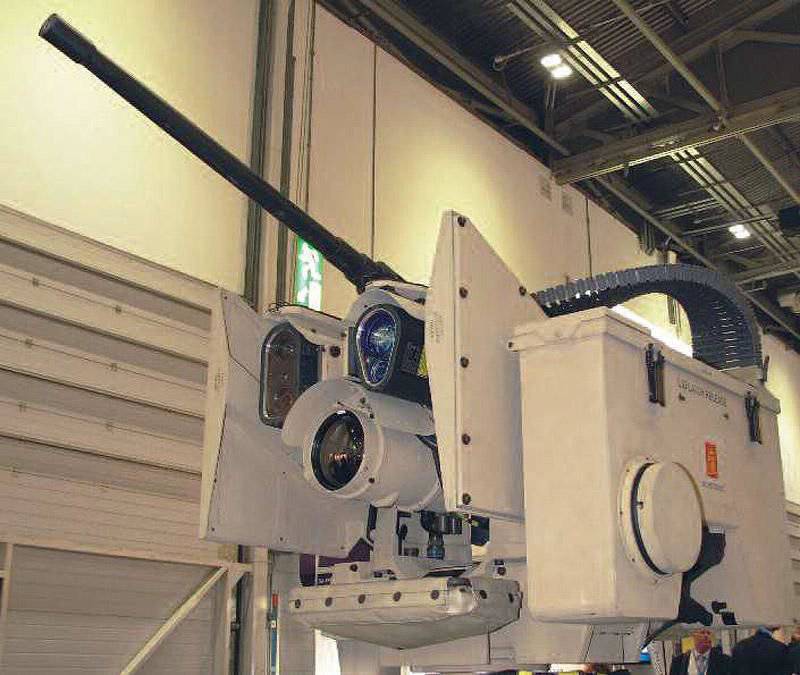
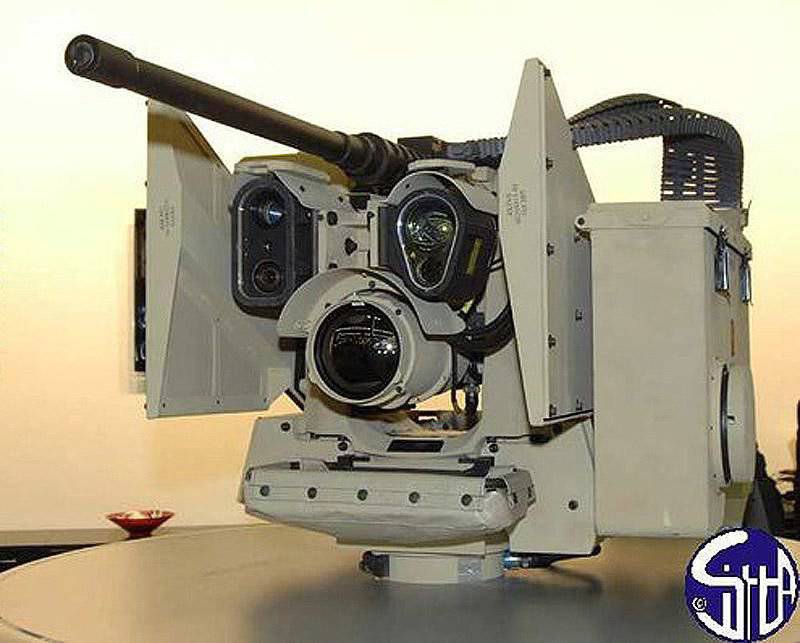
Protector Nordic currently has the most advanced configuration in the Kongsberg protector DBMS family and features a complete optical-electronic kit, “super-elevation” and ballistic protection.
Although installation on vehicles remains the main application of the Protector module, but it is also suitable for organizing a stationary defense system. At the exhibition AUSA 2012, the company showed a container station for armament CWS (Containerised Weapon Station) based on the ISO standard Tricon Type 1 container. The station is equipped with an electromechanical chain hoist, which can raise the Crows II RCWS to the height of a 4,6 meter in less than 30 seconds. The module can also receive a Javelin rocket on the right side (a small electronic unit accommodates matching interfaces). Before the launch, the station switches to rocket mode and the operator can see the image from the homing head of the Javelin rocket. The energy source for the CWS is a multi-fuel generator and battery pack; The Standoff Extension Kit allows you to communicate with the command center at a distance of up to 1 km. Approximately 20 CWS is currently deployed in Afghanistan by the US Army and special operations forces as part of forward base defense systems. For this application, a station of multiple monitoring was specially developed.
Another addition that increases the flexibility of the Protector / Crows family is the transition kit M134 Weapon Adapter Kit (WAK), which allows special forces to install a six-barreled 7,62-mm Gatling M134 machine gun on the company's SDMA. The kit includes a cradle, weapon interfaces, a remote drive, a weapon control unit, a 24 volt battery with a charging module, and a feed mechanism with a 3000 magazine for cartridges. The system is currently being supplied.
Another Sea Protector suite is designed to optimize M153 Protector for marine operations. The kit includes hermetic subsystems and components, an improved corrosion coating, a modified touch kit and an improved tracking system. Kongsberg supplies Sea Protector to the US Navy, where it is known as Mk50, for installation on patrol boats and special operations vessels.
Kongsberg has developed Protector Lite, which has the same user interfaces as the original M151 and M153 modules and is more than 80% compatible with them, to install the DUBM to lighter machines. The Protector Lite version weighs less on the 100 kg than the Nordic Protector, it can be armed with an 7,62-mm M240 or MAG 58 / C6 or 5,56-mm M249 machine gun. The sensor package includes a dual-field imager with electronic zoom, a daytime color camera with an 45 ° field of view and an x30 optical zoom, and a laser-safe laser rangefinder. In the arsenal of the company there is an even easier solution of 30 kg mass, which was named Protector SuperLite. It is currently being considered by different countries in the configuration of the installation on a tripod, especially for special operations forces. The fiber optic cable allows the operator to control the Super Lite module several kilometers away using the new Play Station handheld controller a la developed by Kongsberg, which delivered the first 510 system in October to the 2013 of the year.
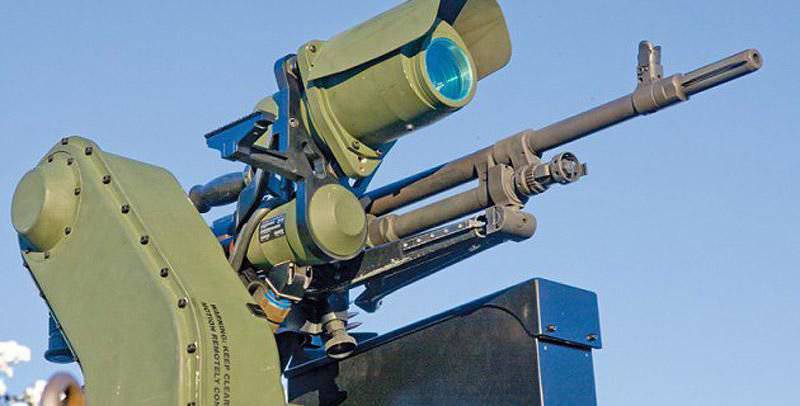
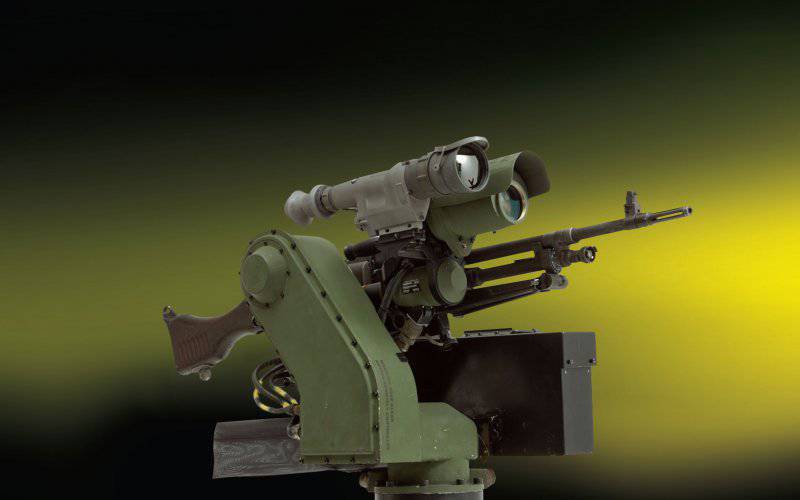
Superlite is the youngest member of the family in the Kongsberg portfolio and can accept 7,62-mm machine guns. In the photo with the installed FN MAG
PRECISION REMOTES
The American company, founded in 1997 in San Francisco, has developed a family of very light RDBs, which can be easily used both in vehicles and in dismounted operations.
The TRAP T360 platform weighs only 34 kg, but can accept 5,56-mm machine gun M249 SAW or 7,62-mm machine guns M240 and MG3. The system can not accept 12,7-mm machine gun, but, however, can take Barrett M82A1M or M107 sniper rifles. The touch kit includes a day camera with a field of view from 1,6 ° to 42 °, a thermal imager and a laser range finder, although sensor independence allows the customer to choose their own touch set. As an option, a non-lethal green laser can also be installed. The TRAP T360 module, fully stabilized in three axes, can be rotated by 360 °; vertical pointing angles range from + 60 ° to -20 °; module electric drives have manual duplication. The fire control system provides a custom aiming point, which takes into account the type of ammunition, range and error from the parallax of the camera. The system stores in memory up to three targets. It can easily integrate external sensors (such as shot detection detectors) that provide a signal to the T360 module. As already mentioned, the T360 module can easily be reconfigured in a few minutes without tools from a portable configuration to a tripod installation. In this case, the power is supplied from batteries, a generator or solar panels, or any network on 10 or 220 AC volts.
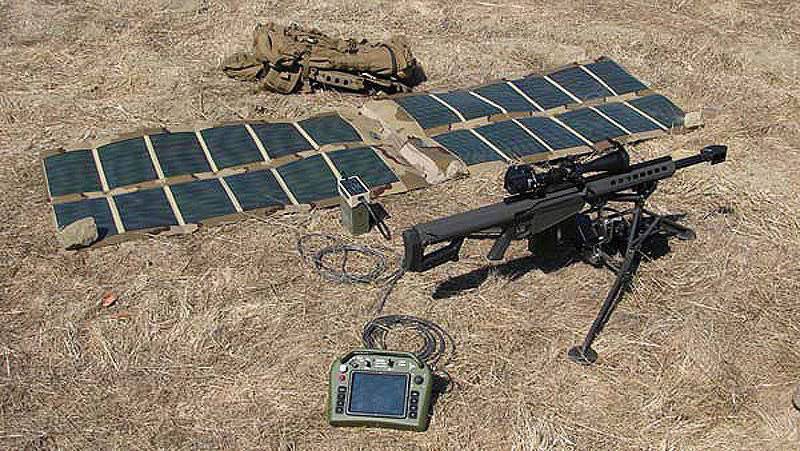
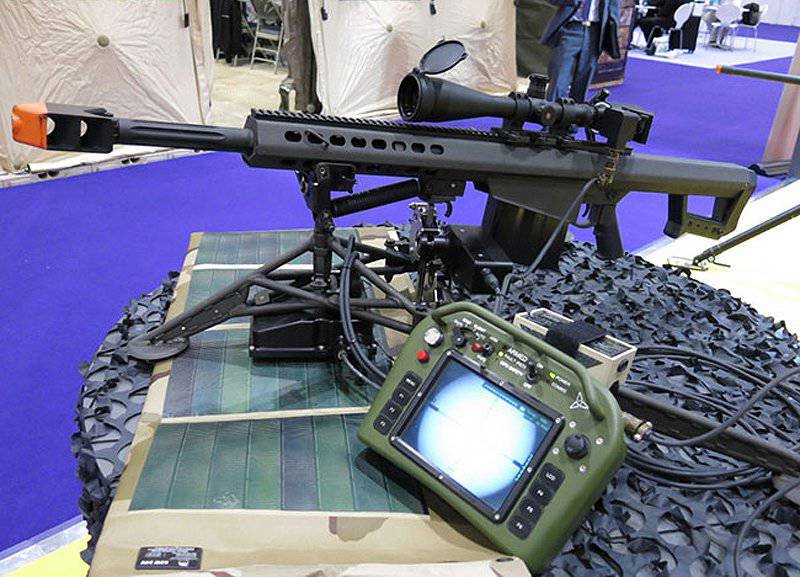
Precision Remotes has developed a remote-controlled module that is easily installed on machines, but can be used as a means of short-range protection for infantry. The system is powered by a mixed circuit using solar panels (pictured above)
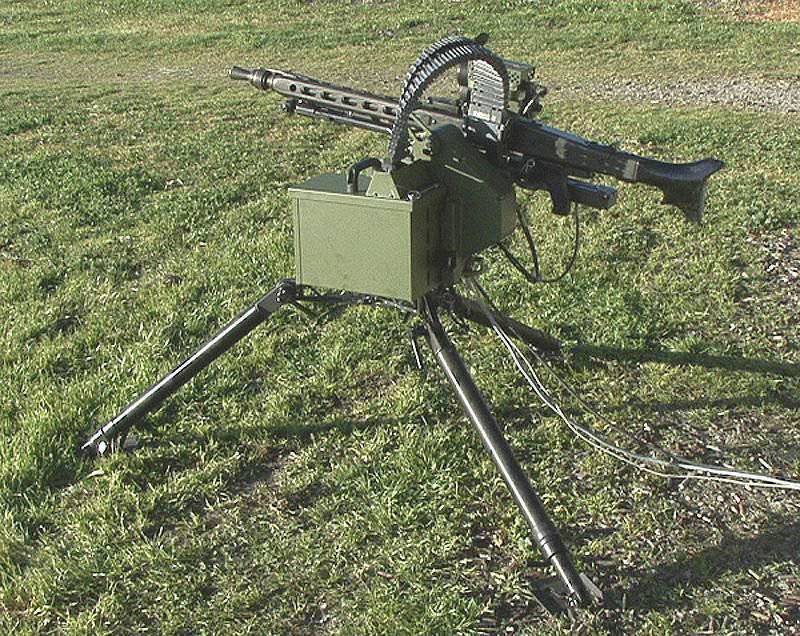
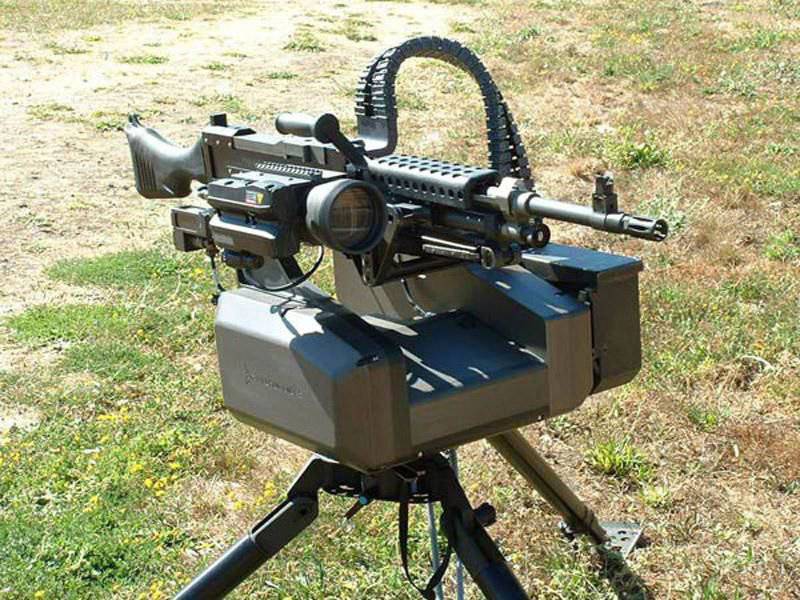
Precision Remotes TRAP T360 can take weapons of caliber up to 7,62 mm (pictured above MG3) and single-shot 12,7 mm rifles
The latter configuration is necessary when TRAP T360 is used to protect stationary positions. To this end, Precision Remotes has developed TRAP 360FS (Facility Security), which has a protective cover in which the system is locked in a safe position and, if necessary, is deployed in less than 5 seconds. They are connected to a control point with several operator consoles and a dispatcher console. Operator consoles include a pointing monitor showing the image from the camera, a touch-screen monitor, which displays an object map highlighting weapon stations and their status, and a control panel. Operators can switch from one module to another with one touch of the screen, select sensors, open or close one or all of the DBMS simultaneously, pre-select targets and fire barriers, select shooting mode and open fire after permission from the controller console with a touch screen and control panel . In developing the system, security was among the top priorities. Precision Remotes systems are used in America to ensure the safety of critical infrastructure, such as nuclear power plants. The TRAP 360FS module can adopt the same armament as standard 360 plus sniper 7,62-mm rifles SR 25 and LR 308. The company also developed TRAP T360I to protect stationary objects. This model is designed for hanging from the ceiling; Only an M240 machine gun with 180 cartridges can be installed into it. The stabilization system is not included in the T360FS and T360I modules, as these are unreasonable costs for stationary applications. However, if necessary, both options can get the stabilization function. Precision Remotes has received requests for the possibility of installing T360I on airships or even helicopters, and there must be stabilization.
The newest addition to the Precision Remotes portfolio is NetROWS, a small black box that allows you to network up to 16 SDM ROWS and manage them with a netbook. It was developed by numerous requests to connect T360 modules with the existing command center for the development of the same company; and since the latter never underwent testing for the security of the control of the combat module, the project often stopped, and the combat module remained separately controlled from the command center, which did not allow to reach the maximum speed of response. NetROWS was created to securely and securely connect to the command center. Its dimensions make it possible to carry out a quick installation of a temporary protection system at an advanced base or checkpoint, which allows you to get the benefits of similar, but long-term systems used to protect important objects. After detecting a threat, a signal is sent to the command center, and its location is transmitted directly to the combat module. The combat module turns directly at the target, then the operator confirms the threat and opens fire.
ELECTRO OPTIC SYSTEMS
The Australian company Electro Optic Systems (EOS) with a branch in the United States has in its catalog two lightweight ABSs under the designations EOS R-200 and R-400. In America, the company entered into an agreement with Northrop Grumman, which owns 8,8% of Electro Optic Systems shares, to jointly study the market for remote weapon systems in the country. And in 2012, an agreement was signed with the South Korean company Hyundai-Wia for production. The lighter module R-200 still remains at the prototype stage. Four prototypes of this module were sent to the US contingent in Iraq. It can be armed with 5,56-mm and 7,62-mm machine guns, but the weight is increased to 80 kg with the installation of the M240 machine gun with 200 cartridges. An optoelectronic set is installed in the module fully stabilized, which includes a day camera with a magnification of x30, a cooled thermal imager and a laser range finder with a range of 7,5 km. In addition to its self-defense capabilities, the R-200 module also provides the crew with significantly better reconnaissance and targeting capabilities.
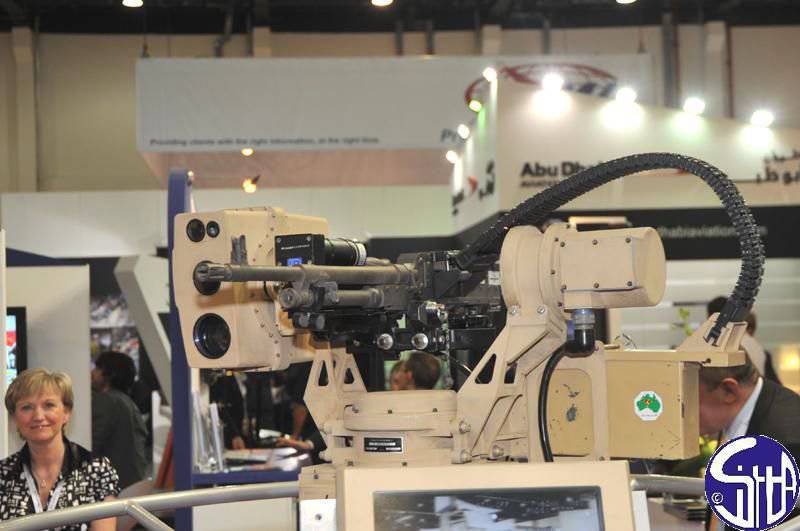
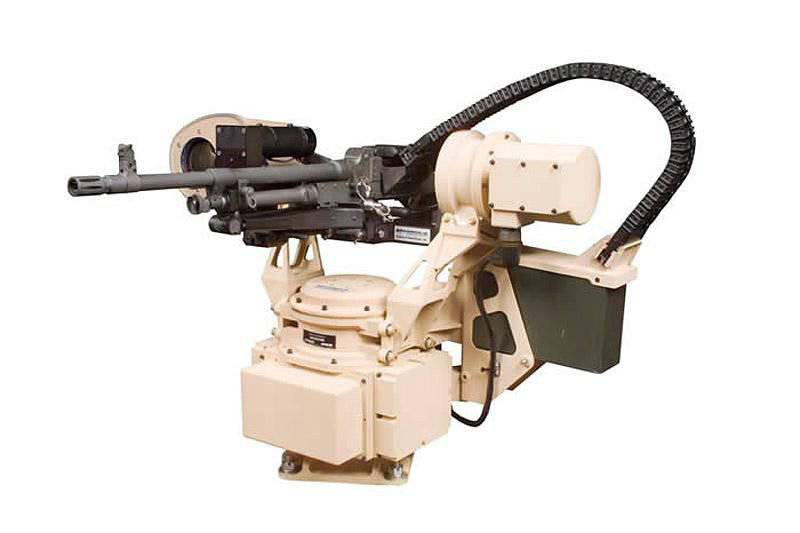
The lightweight ROBD R-200, developed by Australian company Electro Optic Systems, was adopted in small quantities by the American Armed Forces.
The R-400 module is a best-selling company that has been sold over 500 systems. He won the first contract on the Crows module and is also in service with the Australian and Dutch armies. The R-400 can accept machine guns of calibers from 5,56 to 12,7 mm and 40-mm automatic grenade launcher; its mass reaches 250 kg with 12,7-mm machine gun and 500 cartridges. The opto-electronic kit is the same as in the R-200 module. The core components are 2 level security. While the R-200 and R-600 modules are made of aluminum, the R-400 module has a steel structure. It was chosen to be mounted on the C-295 Airbus Military, which is armed with an ATK's M30LF 230-mm cannon, currently deployed in Jordan.
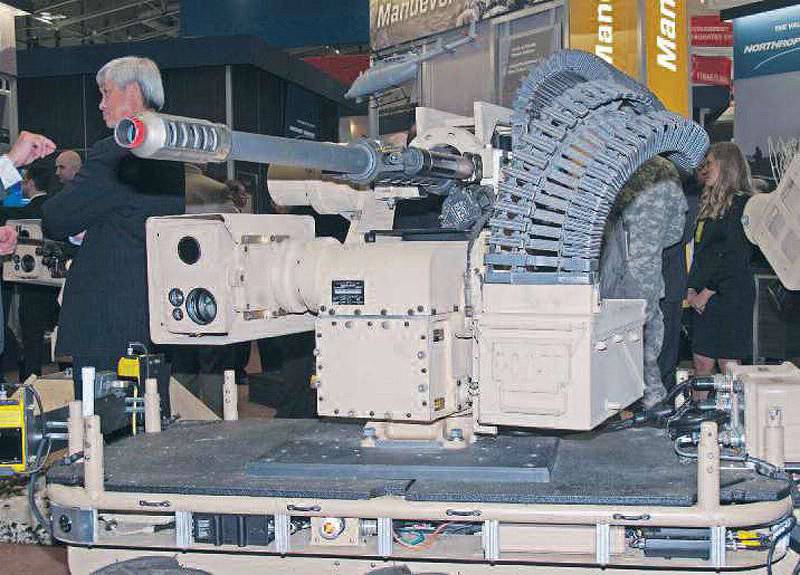
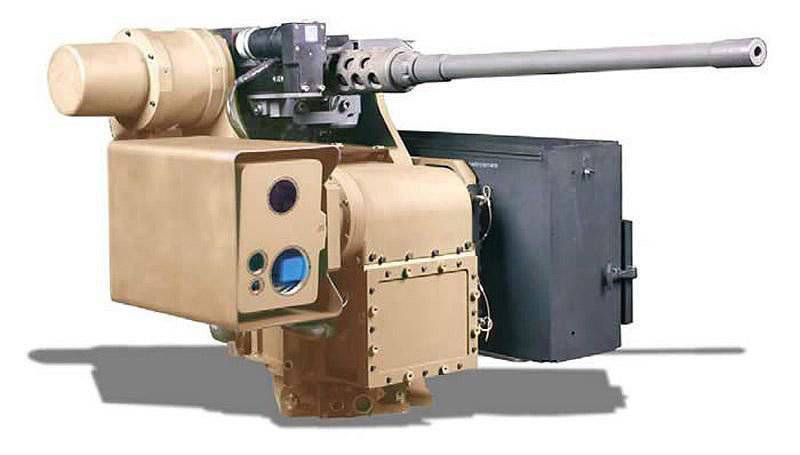
The EOS R-400 module is a lightweight system, but it is nevertheless capable of accepting a medium-caliber cannon with low recoil forces.
FN HERSTAL
The Belgian arms manufacturer has in its portfolio two modules deFNder Light and deFNder Medium, the release of which began in 2011 and 2012, respectively. The Light module can accept 7,62-mm machine guns MAG and Minimi and 5,56-mm Minimi, in the basic configuration with full ammunition “above deck” weight varies from 75 to 85 kg. The armament is installed on the left side of the module, the cartridge box is under the armament; the module, shaped like a very conventional letter U, is made of aluminum alloy. A standard box holds 250 or 200 cartridges, although a higher box can hold up to 600 7,62-mm cartridges or 1050 5,56-mm cartridges.
The container for opto-electronic sensors is located on the right side, in which a color CCD camera is mounted with magnification in the base version. Optionally, an uncooled thermal imager with a double field of view, a laser range finder are offered, and in this case a ballistic computer is added to the system. Under the roof is the operator's console with a color LCD panel with a resolution of 1024x768 pixels and a control handle; target tracking and autoscan functions are also available. The basic deFNder Light module is not stabilized, stabilization along two axes is optionally offered along with modular protection 1 level. Most of these systems are installed on vehicles, however, large vertical angles from –60 ° to + 80 ° allow them to be used for other tasks, such as protecting military bases.
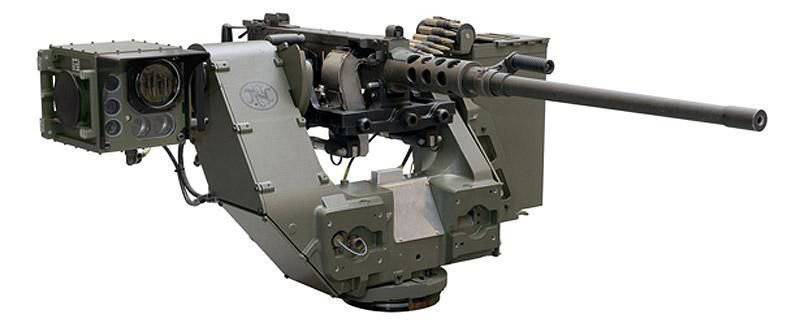
FN HERSTAL deFNder Medium module
The second deFNder Medium system can take on the same weaponry as the Light version plus FN machine guns of caliber up to 12,7 mm (M2HB-QCB and FN M3R, the latter has 1100 rounds of fire per minute) and 40-mm automatic grenade launchers. Depending on the configuration, its mass varies from 150 to 190 kg. The architecture of the modules is similar, the optoelectronic package is offered in two versions: with a CCD camera and an uncooled thermal imager or with a CCD camera and a cooled thermal imager. The options are the same as for the Light variant, the ballistic protection is also the 2 Level plus a smoke grenade unit module is available. 500 12,7-mm cartridges or 1000 7,62-mm cartridges maximum capacity. As in the case of Light, the declination angle significantly exceeds the declination angle of most of its competitors -42 °, and, having also the maximum elevation angle + 73 °, the module has considerable operational flexibility. After signing a contract with one of the NATO fleets, the new version of Sea deFNder Medium is currently undergoing qualification tests.
As usual, FN is not very talkative about its customers. It confirms that deFNder Light and deFNder Medium DBMS have a certain commercial success, contracts for hundreds of modules have been concluded with unnamed buyers from NATO countries and not only.
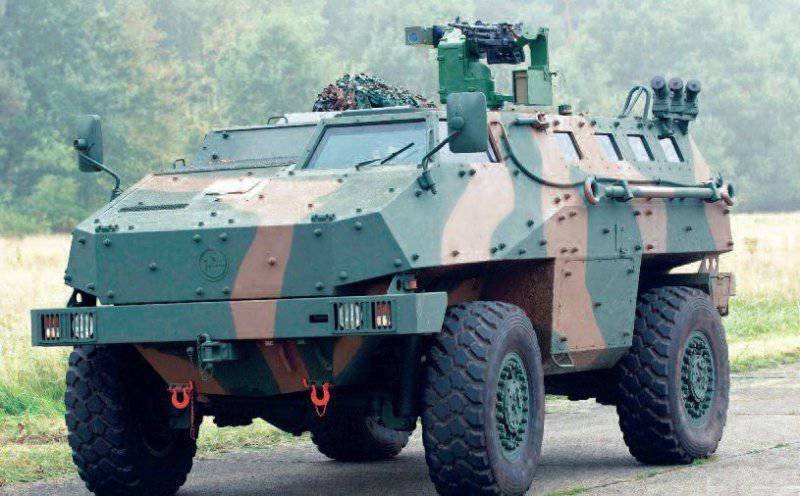
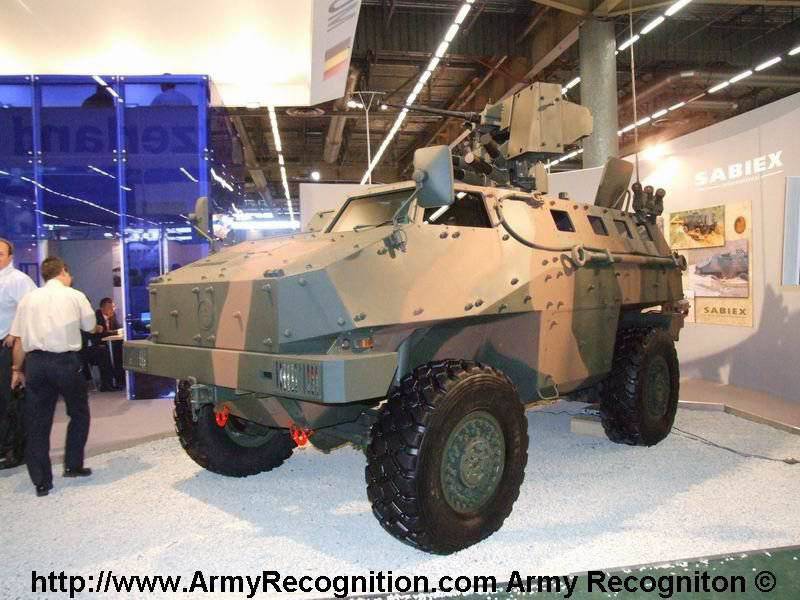
The deFNder Light module is installed on the Iguana machine. This UAB, developed by the Belgian company FN Herstal, can accept 7,62-mm machine guns (pictured above FN MAG)
KRAUSS-MAFFEI WEGMANN
In the middle of 2000, KMW began the development of the Fernbedienbare Leichte Waffenstation 100 (FLW100 is a remotely controlled lightweight combat module 100), which was created based on the requirements of the German army; and the second version of FLW200 soon followed. The main difference is that the former can take weapons of caliber up to 7,62 mm, while the latter can be armed with an 12,7-mm machine gun and even an 40-mm automatic grenade launcher (AH).
When replacing weapons, the system automatically recognizes the new and adjusts the ballistic tables accordingly. The number of cartridges depends on the combat mission, for the 7,62 mm caliber there are two cartridge boxes available, respectively with 120 and 250 cartridges; a box of increased capacity for 480 rounds is currently being installed under the MG3 machine gun; for 12,7-mm armament, there is a box with either 100 or 200 cartridges, while for 40-mm AG the ammunition load comprises 32 grenades. Both modules are installed on the roof without penetration into it, above the roof the mass is respectively 80 and 160 kg without weapons and ammunition. Vertical pickup angles are –5 ° / + 75 °, which allows you to conduct combat operations in the city and mountains.
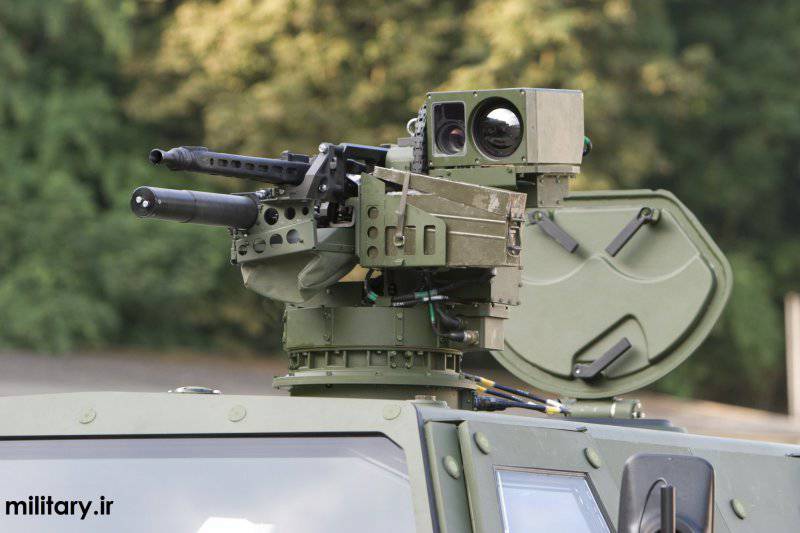
FLW100 is a lightweight member of the Krauss-Maffei Wegmann family, armed with an 7,62-mm machine gun and mounted on Dingo Bundeswehr machines.
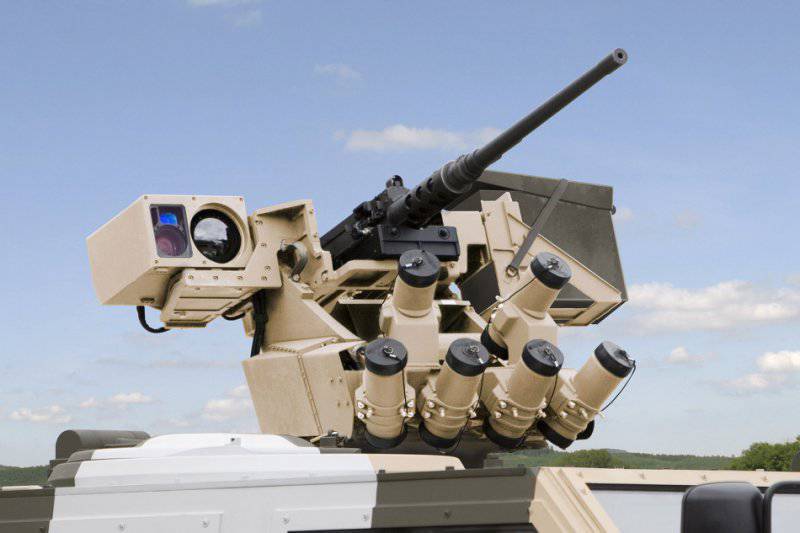
The picture shows the FLW200 module with the Wegmann smoke grenades 76. Can accept machine guns of caliber up to 7,62-mm. This module is installed on Qatari Leopard 2 tanks.
Both modules are electronically stabilized in two axes, the weapons and the optical-electronic kit are stabilized separately. In FLW100, the optoelectronic unit is located to the left of the weapon, behind the cartridge case, with FLW200, the instrument cluster is located to the right. Also, for both models, common sensors: a daytime CCD camera with x10 magnification for day operations offers an identification range of 1,5 km, an uncooled thermal imager 640x480 with an identification range of 1 km. In the FLW200 module, it can be replaced by a cooled thermal imaging camera with an identification range of 2 km. The modular design allows you to adapt the optical-electronic node to the needs of the customer. The control system and the 12-inch color display are the same for both modules.
Since 2008, the Bundeswehr has bought a total of over 920 modules that have been installed on all types of vehicles of the German contingent in Afghanistan, for example, Dingo 1 and 2, Boxer, Fennek, TPz Fuchs and Eagle IV. To increase the level of protection, the Wegmann 200-mm smoke grenades were installed in the FLW76 module, and for educational purposes, the Agdus laser simulation system was integrated into both modules. KMW received an export order from Qatar, where FLW200 was installed on the Leopard 2 A7 MBT tower.
KMW continues to upgrade the FLW100 / 200 systems in accordance with the lessons learned in the fighting. The non-lethal Wegmann 100 mm system is adapted for the FLW40 module. The 7,62mm H&K 121 machine gun is being considered as a possible replacement for the current MG3 machine gun. As for the FLW200, this module integrates a 12,7 mm Rheinmetall RMG machine gun with electric drives. Another recent improvement is an increase in the ammunition load up to 480 rounds for the MG3 machine gun in the FLW100 module. Multi-position control is also underway to allow more than one soldier to observe and fire from the module. The list of potential improvements also includes an ammunition counter, a high pressure cleaning system for sensors, networking, warning sensors and a combat control system.
Company DYNAMIT NOBEL DEFENSE
Best known for their anti-grenade installations, Dynamit Nobel Defense has in recent years manufactured two lightweight modules that can accept machine guns and rocket launchers Panzerfaust and RGW. In a lighter system Fewas 80 installed 5,56-mm or 7,62-mm machine guns, on the right is a typical armored container with a CCD camera, a thermal imager and a laser rangefinder.
The large Fewas 120 module can be armed with machine guns with a caliber up to 12,7 mm or 40-mm AG, its architecture is similar to the architecture of the youngest member of the family, although the larger container accommodates sensors corresponding to the weapon range. This option can also accept launchers of the Panzerfaust and RGW90 families from DND. All installed weapons are calibrated along the line of sight to various distances, this data is transmitted to the computer. When shooting, the shooter should only “highlight the target”, set the crosshair on the target and pull the trigger. Fewas 80 and 120 modules were sold in large quantities to armies around the world.
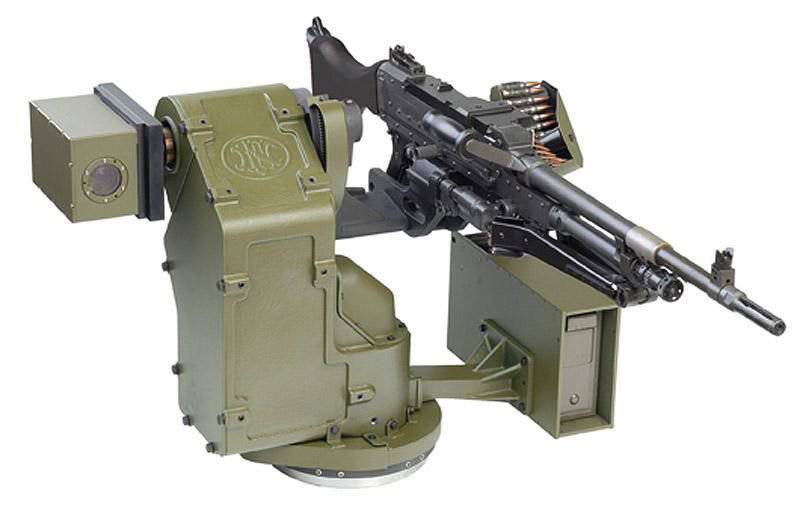
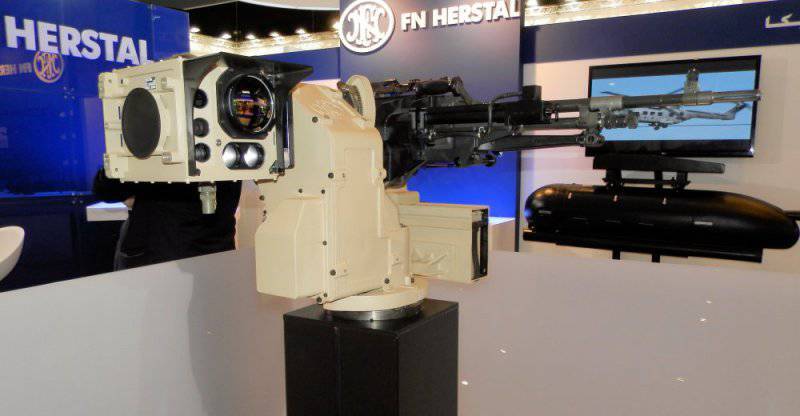
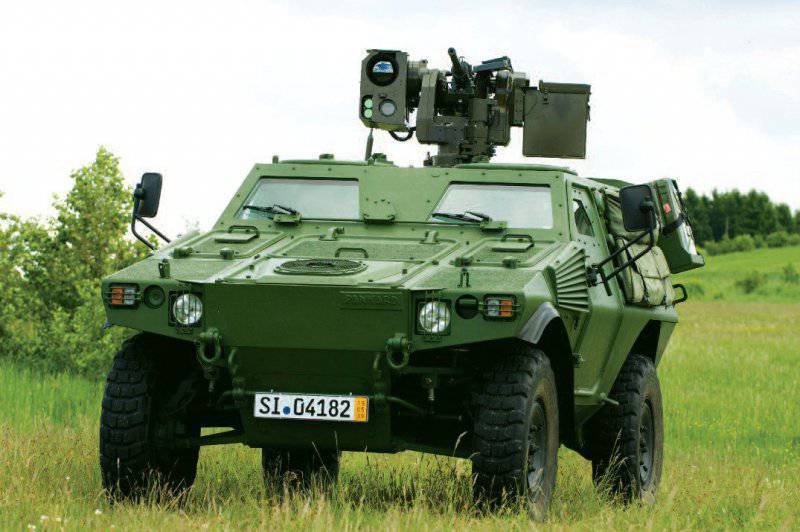
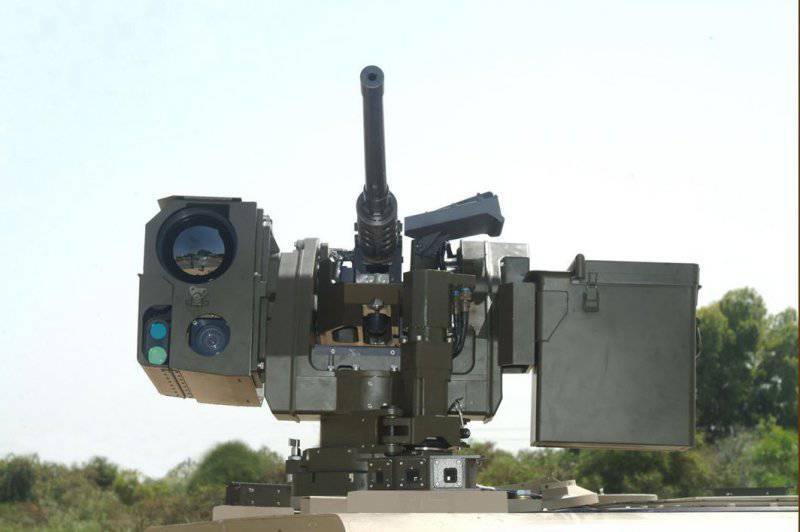
Information